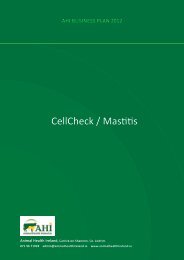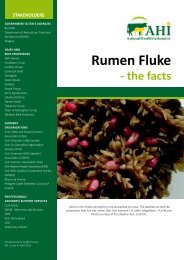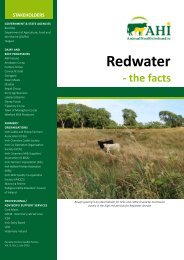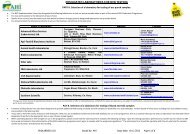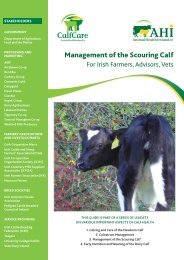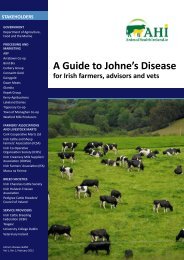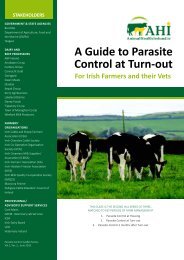Calving and Care of the Newborn Calf - Animal Health Ireland
Calving and Care of the Newborn Calf - Animal Health Ireland
Calving and Care of the Newborn Calf - Animal Health Ireland
Create successful ePaper yourself
Turn your PDF publications into a flip-book with our unique Google optimized e-Paper software.
3<br />
How can you MANAGE CALVINGS to reduce calving problems <strong>and</strong><br />
calf losses?<br />
1<br />
2<br />
3<br />
Calve all heifers <strong>and</strong> cows in a calving unit<br />
Clean<br />
calving pens<br />
<strong>and</strong> housing to<br />
minimise<br />
disease<br />
<strong>Calving</strong> facilities should be clean, well-bedded <strong>and</strong> well-illuminated <strong>and</strong> have an adequate<br />
supply <strong>of</strong> clean water. They should be equipped with a self-locking restraining gate (preferably<br />
suitable for Caesarean Section) <strong>and</strong> should not be used to accommodate sick cattle.<br />
Individual calving boxes are preferable. Depending on <strong>the</strong> precalving movement policy, <strong>the</strong><br />
calving pattern <strong>and</strong> <strong>the</strong> residency time in <strong>the</strong> pen, at least one individual calving pen (4m<br />
by 4m) may be required per 25 cows.<br />
Well-managed, group-calving units (loose pens, pads, paddocks) can also provide suitable calving<br />
accommodation. (See AHI website www.animalhealthirel<strong>and</strong>.ie regarding issues on Johne's Disease <strong>and</strong> group<br />
calving facilities.)<br />
Move pregnant animals to <strong>the</strong> calving unit before calving begins<br />
• Moving pregnant animals to <strong>the</strong> calving unit before calving begins reduces stress at calving, which can be<br />
a particular problem in heifers.<br />
• Inspect <strong>the</strong> animals near to calving (based on breeding/pregnancy detection records) at least twice daily,<br />
<strong>and</strong> move <strong>the</strong>m into <strong>the</strong> calving unit when you detect signs <strong>of</strong> impending calving (see below).<br />
• If a cow is already ‘sick to calve', when first observed, it may be better to wait until she has started to calve<br />
(waterbag or foetal hooves are visible) before moving her into <strong>the</strong> calving unit. This advice applies<br />
particularly in <strong>the</strong> case <strong>of</strong> heifers.<br />
Signs that calving is close:<br />
o s<strong>of</strong>tening <strong>of</strong> <strong>the</strong> pin bone<br />
ligaments<br />
o swollen udder<br />
o dripping colostrum.<br />
Observe all calvings if possible<br />
Observe<br />
all calvings if<br />
possible<br />
‘Sick to calve’ signs to look for:<br />
o tail raised<br />
o mucus at vulva<br />
o restless - st<strong>and</strong>ing <strong>and</strong> lying<br />
frequently.<br />
• If cows are 'sick to calve', keep a discreet eye on <strong>the</strong>m every two hours. Do not move,<br />
disturb or unnecessarily h<strong>and</strong>le cows during this period. Supervision does not imply<br />
intervention, as most calvings do not require assistance.<br />
• Keep a particularly close eye on high-risk calvings or calvings which are likely to be<br />
prolonged, e.g. overfat heifers, heifers in calf to a sire known to produce big calves, cows<br />
carrying twins <strong>and</strong> cows with a history <strong>of</strong> milk fever.<br />
• <strong>Calving</strong> cameras can be a useful aid to reduce <strong>the</strong> workload involved in 24h calving supervision <strong>and</strong> to<br />
avoid disturbing <strong>the</strong> calving, particularly for heifers which are more sensitive to stress.<br />
• Evening or nightime feeding can reduce, although not eliminate, <strong>the</strong> number <strong>of</strong> night calvings.



